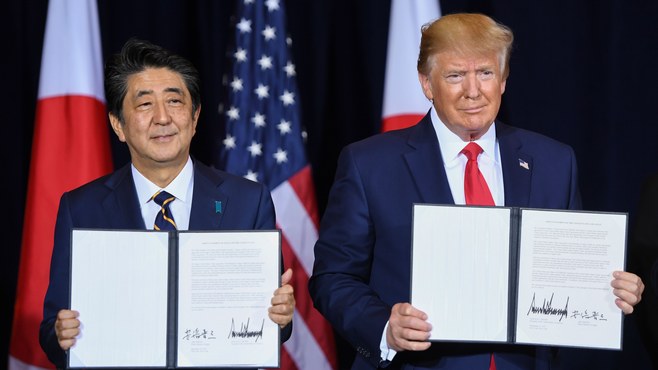- On October 7, the "Japan-US Trade Agreement" was signed along with the "Japan-US Digital Trade Agreement". Both agreements are expected to be approved in Japan's extraordinary Diet session and enter into force on January 1, 2020.
- The Japan-US trade agreement, in line with the Japan-US joint statement issued in September last year, has achieved what both countries had respectively hoped for the most. On the other hand, the agreement is "partial" because both countries gave priority to an early agreement.
- The agreement is a "first-stage initial tariff agreement". Japan and the United States have pledged to reduce or eliminate tariffs on only about $7.2 billion of each other's goods. The second stage of negotiations is expected to be tough for Japan
In line with the Japan-US joint statement issued in September last year, the Japan-US trade agreement has achieved what both countries had respectively hoped for most. Japan was able to keep the liberalization of agricultural products under the agreement at or below the level of liberalization under the TPP. It was also confirmed that "both nations will refrain from taking measures against the spirit of these agreements and this Joint Statement", with the limitation of "while faithfully implementing these agreements" included in the newly Japan-US joint statement. The Government of Japan views this as a commitment by the United States not to impose restrictions on imports of automobiles and auto parts from Japan under Article 232 of the Trade Expansion Act of 1962. Contrary to this view, Ambassador Robert Lighthizer said, "at this point, it is certainly not our intention, the president's intention, to do anything on autos, on 232s, on Japan."
With regard to beef and pork, the United States was able to get equal treatment to its competitors in the Japanese market, namely the member states of the CPTPP (Comprehensive and Progressive Trans-Pacific Partnership, or TPP 11) and the EU. In addition, the United States was able to maintain tariffs on autos and auto parts and only make commitments on "further negotiations with respect to the elimination of customs duties." That is why Prime Minister Shinzo Abe called the deal "win-win" for both Japan and the United States.
The Japan-US trade agreement was concluded less than six months after the start of negotiations. Even though the TPP was available as a basis for negotiations, this speed is unusual, and was probably achieved because the United States placed top priority on an early agreement. The entry into force of the CPTPP at the end of last year and the Japan-EU EPA on February 1 this year placed US exporters at a competitive disadvantage in the Japanese market. In particular, the MFN tariff rates on beef and pork are virtually applied to the United States only. For example, the tariff rate on beef is currently 38.5% for beef from the United States but 26.6% for beef from parties to the CPTPP such as Australia and Canada. The United States was impatient to resolve this disadvantageous situation as soon as possible.
It would also have been necessary to provide new export opportunities to US agricultural producers targeted by China's retaliatory tariffs due to trade friction between the United States and China. With the friction with China prolonged, rapid progress was not made on congressional approval of the USMCA and, with little progress in trade negotiations with the EU, the United States apparently hurried up negotiations with Japan as "the lowest-hanging fruit".
The Trump administration took the unusual step of avoiding time-consuming congressional authorization by taking advantage of Article 103 (a) of the Bipartisan Congressional Trade Priorities and Accountability Act of 2015. In accordance with the Act, the United States promised to eliminate tariffs on only items with tariffs of 5% or less and halve tariffs on items with tariffs exceeding 5% under the agreement.
Due to the importance of speed in the negotiations and the legal requirements of the United States, the agreement covers only a limited number of items. Japan pledged to reduce or eliminate tariffs on about $7.2 billion of agricultural products, and the United States on about $7.2 billion for 42 agricultural products (about $43 million) and 199 industrial products (about $7.17 billion). As Foreign Minister Toshimitsu Motegi said, "the deal strikes a balance between agricultural and industrial products".
According to the Government of Japan, the tariff elimination rates of the agreement are approximately 84% for Japan and 92% for the United States (on a trade value basis). The figure for the US includes the amounts for autos and auto parts. If these amounts are excluded, the US tariff elimination rate would likely fall below 60%. Article 24 of GATT calls for the elimination of tariffs on "substantially all trade" in regional trade agreements between developed countries, with a target tariff elimination rate of 90%. It is hard to say that the agreement satisfies this target at this point. If the US will not eliminate tariffs on autos and auto parts in future negotiations, the agreement will be inconsistent with the WTO rule.
The USTR calls the Japan-US trade agreement a "first-stage initial tariff agreement." The second stage of negotiations is expected to begin as early as next spring. In the next stage of negotiations, the United States, which is seeking a comprehensive trade agreement, will present Japan with difficult issues, including exchange rate clauses, based on the "specific negotiating objectives" of trade negotiations with Japan compiled by the USTR in December last year. Now that Japan has given up its biggest cards, beef and pork, there are few cards left. The second stage of negotiations will be tough for Japan.
Junichi Sugawara is Senior Research Officer at Mizuho Research Institute Ltd..
The views expressed in this piece are the author's own and should not be attributed to The Association of Japanese Institutes of Strategic Studies.



